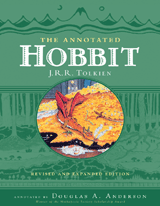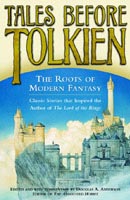TURGON'S BOOKSHELF:
Q&A with Douglas A. Anderson


Douglas A. Anderson is well-known for his work on J. R. R. Tolkien. He has done textual work on both The Hobbit and The Lord of the Rings, and has written introductions to various editions of these books published by Houghton Mifflin. His first book was The Annotated Hobbit, originally published in 1988. It won the Mythopoeic Scholarship awarded by the Mythopoeic Society. A revised and enlarged edition of The Annotated Hobbit appeared in 2002. Quickbeam reviewed the new edition for Green Books and his review can be found here. In December 2002 TORN hosted a chat with Anderson, and it is archived here.
Anderson has been a bookseller in Ithaca, New York, and in northwestern Indiana. He currently lives in southwestern Michigan. His new book, an anthology titled Tales Before Tolkien: The Roots of Modern Fantasy, was published last month by Ballantine Books. A listing of the contents can be found here.
Q: Tell us about your new book, Tales Before Tolkien. Where did the idea for it come from?
A: The idea for the book actually came directly out of my work on the revised edition of The Annotated Hobbit. I felt frustrated in only being able to put in small excerpts from some stories that definitely influenced Tolkien, like E. H. Knatchbull-Hugessen's "Puss-cat Mew," into the annotations in The Annotated Hobbit. So I started thinking along the lines of what a collection of such stories that influenced Tolkien might be like. After thinking it over for a while, I decided that the best approach would be to highlight some stories that Tolkien definitely knew and which can be seen to have influenced him, and round out the rest of the book with other examples of what fantasy was like before Tolkien came along and made new rules.
After I had thought it out, I approached Ballantine Books. They have published Tolkien in mass market paperback in the U.S. since the mid-1960s, and they have been a leading publisher of fantasy and science fiction for many years. Plus I think back fondly to the Ballantine Adult Fantasy series (the first series of its kind) which ran from 1969-74, and which introduced me to many excellent writers, several of whom appear in my anthology. Ballantine seemed to me a perfect fit as publisher for the book, and happily they felt so too.
Q: So was this an easy book to put together?
A: Well, yes and no. I've read fantasy literature, especially the older writers, for many years. In fact there isn't a single item in the book that I hadn't read at least once before in the last twenty years. Some of them I've read many times. So in one sense it was a pleasure to reread a lot of good stories to consider for inclusion. But the matter of selection itself I found to be a bit more difficult than I had expected. I firmly believe that the concept for a book evolves in the editor/writer's mind almost like an organic thing while you are working on it -- it does for me at least! The book takes on a shape of its own, and a life of its own, and you need to listen to that inner voice that nags you when, stubbornly, you're persisting in a wrong direction. All of my books have in the end turned out slightly but significantly different from how I first planned for them to be, and in every case I think it's been for the better.
Q: The book has a gorgeous cover.
A: Yes, that's by John Howe, whom we all know worked as one of the conceptual artists for Peter Jackson's movies. It's his painting of Minas Tirith, and the way he has used light in the sky and on the towers reminds me of Maxfield Parrish. It gives a perfect appearance to the book -- kind of a romantic feel of an elegant past, which reflects the content within the book nicely.
Q: Did you select the art for the cover?
A: No, my editor at Ballantine, Betsy Mitchell, chose it, and asked me what I thought. John Howe's illustration of "Smaug over Esgaroth" is one of my favorite illustrations out of those by all of the Tolkien illustrators. So it was Betsy's great idea, which I was more than happy to go along with it.
Q: Any especial favorites in the collection?
A: Three of my favorite writers are represented -- writers I've gone to great lengths to read everything they've written. Lord Dunsany wrote the best fantasy fables (among other things) in the English language, while Kenneth Morris wrote superlative original fantasies grounded in various mythologies from around the world -- from Celtic to Buddhist, and Taoist to Toltec. And David Lindsay is simply one of my absolute favorite writers. His extremely imaginative book, A Voyage to Arcturus, inspired C. S. Lewis's Out of the Silent Planet and Perelandra. Lindsay wrote only seven novels but no short stories. I'm extremely pleased that I was able to arrange with Lindsay's daughters to print his fairy play for the first time. It's a fun work in itself, though rather different from his novels, which are metaphysical fantasies.
And though I don't especially like extracts, I put in one of my favorite sections, "Golithos the Ogre," from E. A. Wyke-Smith's The Marvellous Land of Snergs, which was source for Tolkien's ideas about Hobbits. Golithos is a reformed ogre who no longer eats children but who has become vegetarian.
Q: Any particular novels by these writers that you'd recommend for people to start with?
A: I give several pages of notes on recommended reading, for these and other authors, at the back of my book. For Dunsany there is an omnibus in England called Time and the Gods. Unfortunately Kenneth Morris's short stories aren't presently in print. But the volume I edited in 1995, The Dragon Path: Collected Tales of Kenneth Morris, is the one to get and can be found fairly easily through the used book sources on the web. For Lindsay, A Voyage to Arcturus is probably the one to start with. It's currently available in an edition from the University of Nebraska Press with a truly godawful, execrable cover. It's the perfect example of why one should never judge a book by its cover alone. There is also a British edition available, with a much better cover. It's part of the Fantasy Masterworks series published in England by Millennium. In fact that whole series, which currently has thirty-some books in print, is excellent. Great books by some of my other favorite writers are available in that series, like The Emperor of Dreams by Clark Ashton Smith, and The Land of Laughs by Jonathan Carroll. And of course I have been recommending for years E. A. Wyke-Smith's The Marvellous Land of Snergs.
Q: What authors didn't make it into the book that you would have liked to include?
A: Given the constraints of considering only authors slightly older than Tolkien, I regret that there is nothing in it by E. R. Eddison. He simply wrote no short stories, and an excerpt from one of his novels just wouldn't stand well on its own. So I'd recommend people search out his Worm Ouroboros. Tolkien called Eddison "the greatest and most convincing writer of invented worlds that I have read."
And Hope Mirrlees wrote a brilliant book, much admired by Neil Gaiman, called Lud-in-the-Mist. It's about a small unimaginative town near the borders of Faerie and its problems with the illegal fairy fruit. But Mirrlees, too, wrote no short stories.
There are a lot of authors just slightly younger than Tolkien whom I would have loved to include. I have quite a thick file of stories that I love that simply wouldn't fit in for reasons of space.
Q: So does that mean we can look forward to another book, More Tales Before Tolkien, or maybe even Tales After Tolkien?
A: Either would be interesting. But there haven't been any discussions about possible follow-ups. I'm sure the publisher would want to see how this one does before even considering a further volume.
Q: To turn to a specific point in your Introduction, you mention that some of the medieval legends of Alexander were the inspiration for Tolkien's Two Trees in Valinor. I've never before seen a source mentioned for the idea of the Two Trees. Can you elaborate?
A: Today we tend of think of the Matter of Britain, including all of the stories of King Arthur, as the greatest body of medieval legendry. But there is as large a tradition of medieval literature about Alexander the Great, much of which is forgotten today. Some of these legends are very fanciful, and in at least one Middle English version Alexander travels to the Far East where he encounter the Trees of the Sun and Moon, which he consults like oracles and they foretell his future.
Tolkien himself is the authority for this comment. An interviewer asked him in 1965 if his Two Trees were in any way a reflection of the World Tree in Old Norse mythology, and Tolkien responded: "No, no, they're not like it; they're much more like the Trees of the Sun and Moon discovered in the Far East, in the great Alexander stories."
Q: The book has been published simultaneously in hardcover and trade paperback, which seems an unusual thing for a publisher to do nowadays. Why was this done?
A: It is unusual, but even when I first had the idea for the book I thought that a dual format was the way to go with it. Having been in the publishing and bookselling industry for twenty years, I felt that the book's natural audience would be in trade paperback. But libraries like hardcovers since they are far more durable than paperbacks, and Tolkien collectors, as well as some other readers, prefer the hardcover format too, so I think in this case it is ideal to have the choice of format. Of course it was the publisher's decision to do the dual format, but we all agreed on its desirability without even discussing it.
Q: What's your next book?
A: Well, I've usually got my fingers in three or four different projects at any given time. I have some edited short story collections by older weird fiction writers coming from specialty presses like Midnight House and Ash-Tree Press. But there is one book for which I've written the Introduction that is coming out towards the end of October that might be of more general interest. It's the first reprinting of a novel from 1825 called The Rebellion of the Beasts; or, The Ass is Dead! Long Live the Ass!. What it is basically is the same story as Orwell's Animal Farm, with the satire directed towards the monarchy. Animal Farm is itself a fine book, but The Rebellion of the Beasts is more wicked and vicious. The author is believed to be Leigh Hunt, the famous essayist and friend of Byron and Shelley. The publisher has a nice write-up about the book at their website.
Thanks!
* *
--Turgon
|
![[ Green Books ]](http://img-greenbooks.theonering.net/images/gb_logo.gif)
![[ Green Books - Exploring the Words and Worlds of J.R.R. Tolkien ]](http://img-greenbooks.theonering.net/images/gb_topnav.gif)




